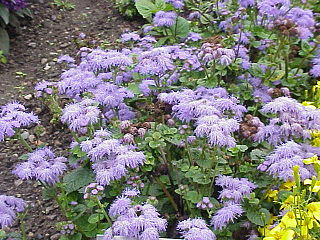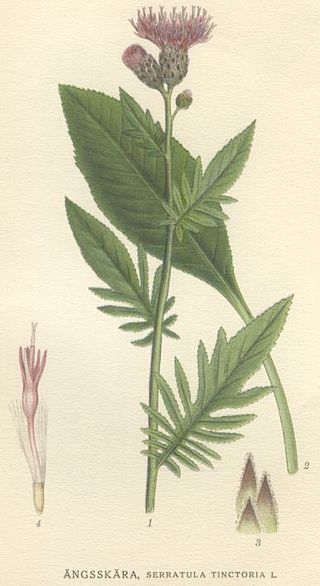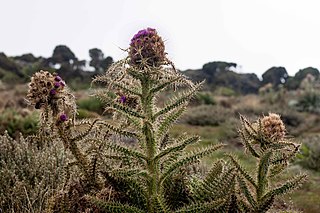
Cirsium is a genus of perennial and biennial flowering plants in the Asteraceae, one of several genera known commonly as thistles. They are more precisely known as plume thistles. These differ from other thistle genera in having a seed with a pappus of feathered hairs on their achenes. The other genera have a pappus of simple unbranched hairs.

Carduus is a genus of flowering plants in the family Asteraceae, and the tribe Cardueae, one of two genera considered to be true thistles, the other being Cirsium. Plants of the genus are known commonly as plumeless thistles. They are native to temperate Eurasia and North Africa, and several are known elsewhere as introduced species. This genus is noted for its disproportionately high number of noxious weeds compared to other flowering plant genera.

Thistle is the common name of a group of flowering plants characterized by leaves with sharp spikes on the margins, mostly in the family Asteraceae. Prickles can also occur all over the plant – on the stem and on the flat parts of the leaves. These prickles protect the plant from herbivores. Typically, an involucre with a clasping shape similar to a cup or urn subtends each of a thistle's flower heads. The typically feathery pappus of a ripe thistle flower is known as thistle-down.

The Heliantheae are the third-largest tribe in the sunflower family (Asteraceae). With some 190 genera and nearly 2500 recognized species, only the tribes Senecioneae and Astereae are larger. The name is derived from the genus Helianthus, which is Greek for sun flower. Most genera and species are found in North America and South America. A few genera are pantropical.

Eupatorieae is a tribe of over 2000 species of plants in the family Asteraceae. Most of the species are native to tropical, subtropical, and warm temperate areas of the Americas, but some are found elsewhere. Well-known members are Stevia rebaudiana, a number of medicinal plants (Eupatorium), and a variety of late summer to autumn blooming garden flowers, including Ageratum (flossflower), Conoclinium (mistflower), and Liatris.

Rhaponticum is a genus of flowering plants in the tribe Cardueae within the family Asteraceae. As of November 2023, it is accepted by Plants of the World Online, but rejected by the Global Compositae Database in favour of Leuzea.

Serratula is a genus of plants in the tribe Cardueae within the family Asteraceae native to Eurasia. Plumeless saw-wort is a common name for plants in this genus. Serratula as traditionally defined contains at least two groups: one of which is basal within the subtribe Centaureinae and one of which is derived; the former group can be moved to the genus Klasea.

The genus Cousinia of the tribe Cardueae is in its current circumscription one of the larger genera in the Asteraceae, with approximately 650-700 described species distributed in central and western Asia.
Oligochaeta is a genus of Asian flowering plants in the tribe Cardueae within the family Asteraceae.

Anthemideae is a tribe of flowering plants in the subfamily Asteroideae, which is part of the family Asteraceae. They are distributed worldwide, with concentrations in central Asia, the Mediterranean Basin, and southern Africa. Most species of plant known as chamomile belong to genera of this tribe.

Jurinea is a genus of flowering plants in the family Asteraceae.

Olgaea is a genus of Asian plants in the tribe Cardueae within the family Asteraceae, having a typical thistle appearance.
Hirtellina is a genus of flowering plants in the thistle tribe Cardueae within the daisy family Asteraceae.

Larinus turbinatus is a species of true weevil in the family of beetles known as Curculionidae.
Vernonioideae is a subfamily of the sunflower family, Asteraceae. It includes seven or more tribes, some of which contain subtribes.

Afrocarduus is a genus of flowering plants in the sunflower family, Asteraceae. It includes ten species of thistles native to the mountains of tropical Africa, ranging from Nigeria to Ethiopia and Zimbabwe.
Afrocirsium is a genus of flowering plants in the sunflower family, Asteraceae. It includes three species of thistles native to the mountains of eastern tropical Africa.
Nuriaea is a genus of flowering plants in the sunflower family, Asteraceae. It includes two species of thistles, Nuriaea dender and Nuriaea engleriana, which are endemic to Ethiopia.













